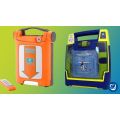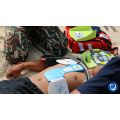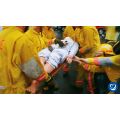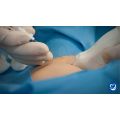HeartTalk with Dianne Atkins
HeartTalk is WorldPoint’s ALL NEW web video interview series where we ask important questions to leading experts in the CPR and healthcare industry to learn about the important topics that affect people today. Exciting, informative, and educational, HeartTalk will provide you with never-before-heard stories, real life industry experiences, and actionable takeaways. Watch HeartTalk to gain fresh and valuable insights into how we can all work together to improve patient outcomes!
WorldPoint was honored to visit Dr. Dianne Atkins, who sat down with WorldPoint's Executive Vice President, Shelly Forté to discuss her career and contributions to resuscitation science. From pediatric cardiologist to chair of the American Heart Association's ECC Committee, Dr. Atkins' career includes a breadth of in-hospital care, research, AHA Guidelines development, and community engagement.
Watch the video now or read the transcript below!
Shelly:
Well, I am so excited to be here with you today, Dr. Atkins. Welcome to HeartTalk. HeartTalk is just really a web series that WorldPoint is bringing to the market where we highlight conversations with industry leaders like yourself, industry leaders who are committed to resuscitation, CPR, CPR training and improving outcomes. And so I'm really excited to be with you here today. Welcome.
Dianne:
Well, thank you so much. I am so pleased to be here to represent the Heart Association to talk about emergency cardiovascular care, community, and everything CPR. It is definitely one of my passions.
Shelly:
Excellent. Well, let's get right into it then. You have this incredible, rich history in the industry. And so maybe just tell us a little bit about who you are and your role in the industry and as much as you can.
Dianne:
So I was trained as a pediatric cardiologist. I did my pediatric cardiology training at the University of Iowa. And when I finished that, I was offered a position on the faculty and I stayed there until my retirement just a few years ago. So I have spent my career taking care of children who are either born with heart problems or acquire them later on in life.
I had a specialty that we call electrophysiology, which is the treatment of rhythm disorders, heart rhythm disorders. And within that group, there is a large proportion of children who are at high risk for sudden cardiac arrest. And I spend a lot of my time talking to families about preventing that or actually treating them once it happened. And so that was sort of the start of my career in resuscitation.
But the real start came back in the—probably mid eighties when Dr. Richard Kerber called me. Dr. Kerber was an adult cardiologist, was actually one of the founders of the Emergency Cardiovascular Care Committee of the American Heart Association. And his research efforts were directed at resuscitation. And he asked me about this technical term—trans thoracic impedance—so what do you know about that in children?
And I hesitated because I didn't know what it was. And he was very kind. And as soon as he realized I didn't know, he explained it to me. And he wanted to know if I would be interested in doing a project to measure that in children. And I said, “Well, yeah, that would be fairly easy for me to do.”
“My patients in clinic, we can do it.” We had an easy way to do it. And so that was the start. And from there, I really became very, very interested in resuscitation as a research opportunity. I continued to do several studies with Dr. Kerber. And then I was asked to join the Emergency Cardiovascular Care Committee, and we call it ECC, as a pediatric representative, and I have been off and on at various times in various roles since the late 1990s.
Shelly:
I am honored to be sitting here with such an icon. So pediatric cardiology, Dr. Atkins, how did you determine that would be your life's focus?
Dianne:
So there are two or three reasons. One, my mother was a nurse and she was a nurse at the Johns Hopkins Hospital in the late 1940s. And that was the time of the Blue Baby operation. And parents were bringing their children with congenital heart disease, who were very blue, to Hopkins to have that life-saving and life-altering surgery.
And she talked about that. And at about that time in elementary school, there was a young girl in my class who—I think I know now what was probably the problem—but she was very blue. Her lips were blue, her nails were blue. She was very limited in her activity. And one summer she went to Hopkins, spent most of the summer in Baltimore, and came back pink because she had had the surgery to repair her heart disease.
And I was fascinated. And then the final thing that probably totally sealed it for me, I went to medical school knowing I wanted to be a pediatric cardiologist. But in the seventh grade, the Bell Laboratories, which no longer exists, circulated a lot of films about science. And we were shown one called “Hemo the Magnificent” that talked about the heart and the blood, because obviously there's a very close relationship.
And in that film there were clips of an open heart operation where the heart was exposed and you could see the coordinated activity of the heart muscle. I was probably the only girl in the class who didn't squeal “ewww.” I was mesmerized. And I have to say, that feeling of watching the heart beat—the upper chambers and the lower chambers— Even now, when I go to the operating room and although I'm not a surgeon, I there are times when I'm in the operating room. I am still just amazed. And now that I can sort of understand what's happening in the heart muscle and I'm and I'm just I'm mesmerized by that beating heart. And that's how I came to be a pediatric cardiologist.
Shelly:
That's amazing. That really is. And I didn't know that about blue babies.
Dianne:
That operation was done first in November of 1944. The little girl's name was Eileen. It's called the Blalock-Taussig Shunt. And I had the opportunity to meet Dr. Helen Taussig, who was considered the founder of pediatric cardiology, when I was a senior in medical school. She was still living at that time, and I had the opportunity to talk to her. And that's just amazing to me.
Shelly:
Wow. You just struck a chord just then. My...so I have twin girls who are now 19, but when one of them was 12 and ran a two and a half mile run for cross-country, she passed out. And that's when we learned that Jaden Eileen Forte had a congenital heart defect. And that was in September. In Christmas week, she was having open heart surgery at Lurie's, was successful, with a rare congenital heart defect. And so that is where my passion and my way comes from. So that resonates.
Dianne:
I definitely can understand that for any child who passes out, there's also a risk of sudden cardiac arrest. And that's we like to, as with your daughter, figure it out before that happens. And so and obviously, Lurie is one of the best children's hospitals in the country. So I'm glad that things have worked out well for you.
Shelly:
Yes. And so I have a special respect and appreciation for your work in this industry. Thank you. So....the American Heart Association. That's been an incredible journey. Can you talk a little bit about how you came to become involved and the roles that you've had and what you do currently for the American Heart Association?
Dianne:
So I became involved with the American Heart Association again sometime early in my career. My boss, the head of pediatric cardiology at the University of Iowa, was very involved. And I think he and actually had Dr. William Friedman, sort of offered my name up to be nominated to serve on the council or the committee that deals with young people and heart disease.
And when I got the invitation, they actually asked me to be on three committees simultaneously. And I went, “Oh, my word!” because I was still a junior faculty member. I was working towards that first promotion. And I asked my boss, Dr. Ron Lauer, should I do this? And he said, “Absolutely.” He said, “The American heart Association is the strongest and the most active organization that promotes treatment of children with heart disease.”
And so that was probably in the early- to mid- nineties. I then eventually became, actually, the chair of that council, which we call now. We call [the] council Young Hearts. And as I rolled off of that back in the early 2000s, I believe I was doing a lot of publishing on resuscitation and especially resuscitation in children.
And so then I was asked to be on the Emergency Cardiovascular Care Committee. And so I have been with that committee. I have participated in virtually every updated guidelines since 2000. So it's, it's a lot. And I currently am now chair of the Emergency Cardiovascular Care Committee of of the American Heart Association.
Shelly:
What an incredible honor and privilege.
Dianne:
It really is. When I got asked, I have to say I hesitated. It's a big responsibility. It's a big job. By the time I was asked, Dr. Kerber had already passed away. But I felt his hand on my shoulder and I said, “I can't say no. Dick would be so disappointed in me.”
And I have done it. It's been an incredible experience. I started my chair in 2021, so in the midst of the pandemic. We were on Zoom, we were meeting on Zoom. And I have to say, I am so proud of the committee members because we continued our work, and our efforts. We were incredibly productive over the last two years, despite all of the restrictions and constraints that the pandemic put on us.
I'm glad to say we are back to face-to-face meetings. It's a very close knit group of people who work together. And we know that, that face-to-face contact cements those relationships. So I'm glad that we are back to that. But it's been a real honor to work with really dedicated and passionate volunteers and to lead them through this process.
Shelly:
So BLS, ACLS, PALS. Let's talk about community response and bystander CPR. There seems to be a lot of awareness right now this year, an interest in bystander CPR training. Can you talk a little bit about your work with Dr. Kerber and his influence on you and the work that you're doing currently around community and bystander?
Dianne:
Yes. So, yes, you are correct that that when I was actively working and practicing, it was mostly in-hospital cardiac arrest. But I did do a lot of outreach. As I said, I had a lot of patients who were at risk for cardiac arrest. So I would go into their schools and and talk to the staff there about having an emergency plan that then they could generalize to all kinds of emergencies.
But my goal was for that particular child. Until I retired from the university, I was not that actively involved in a lot of out-of-hospital activity. But Dr. Kerber died in November of 2016 and it was a pretty unexpected death. He was only ill for about two weeks.
Dr. Kerber, his wife, who is also Dr. Linda Kerber, she's a very prominent historian, saying, “You know, everybody on the medical side of the University of Iowa campus knows CPR. But on the liberal arts side, we have a law school. We have a lot of non-medical programs.” She goes, “People don't know CPR.”
And so I said, “Well, let's start a program at the University of Iowa.” And she and I were talking about this, and we started with her department, the history department. And soon after that, she started talking with Dr. Jim Merchant, who was the dean of our School of Public Health. He had been in the same Department of Medicine with Dick Kerber.
And he also was a Rotarian of was a member of Rotary Club International. And he said this would be a great project for Rotary. And so the three of us got together. So Linda Kerber, Jim Merchant, and myself, and we started meeting for breakfast at this very iconic little restaurant in Iowa City.
We submitted a grant to the to our local Rotary, and they funded us. They started us out with $10,000. And our goal was to provide increased awareness of of cardiac arrest, to provide CPR training—free CPR training—and access to AEDs. We were fully funded and ready to go in February of 2020. We trained—Oh, and our emphasis was going to be faith communities because we knew we could get a large group of people in one spot to train.
And nonprofits—So that was our initial intent. And we trained one group and then the world shut down. So we sort of said, “Okay, we can't train right now, but we still can get AEDs out into the community.” And we started working with a vendor who was able to provide us with AEDs at a reduced cost.
And we set up a fund within the Community Foundation of Johnson County, which is Johnson County, Iowa. And we would provide these AEDs, which came with a wall cabinet, signage, a small pack that would have gloves, face mask, and and scissors and things like that. But if the church or faith community or whomever, we would provide them the AED and we would provide them with CPR training.
But we got the AEDs going first. We have expanded. We have several business people who are also members of Rotary. They have run an incredible, incredibly efficient fundraising campaign. We have raised over $150,000. We spend it almost as soon as we get it for these AEDs. We have manikins. And we now, since about last September or October, we started the CPR training again.
So we are now training all of these groups who, who got the the AEDs from us. So it's very satisfying to me and fulfilling because I've preached this for a long time, that bystanders are an incredible link, incredibly important. And now I'm part of making sure that we have a large community of bystanders who are able to deliver CPR.
And our committee now is probably eight or nine. I'm proud to say that we have a rescuer, somebody who gave CPR to his 3-year-old child when she fell into a pool and he had to drag her out. We have a good friend of mine who's a survivor. She had a cardiac arrest on April the 1st, 1999, and she is doing fantastic 24 years later. And then we've got an attorney who guides us and several business people. So it's just been, you know, it's been phenomenal. And Dr. Jim Merchant has done an amazing job of leading us.
Shelly:
So fulfilling to make that kind of impact in your community. So speaking of your community, I think the beginning of this year there was some news with the Citizen CPR Foundation.
Dianne:
We earned the certification as a Heart Safe Community. This is something that you earn through the Citizen CPR Foundation. You have to provide certain statistics about your community. You have to know how many people you are training and you have to reach a certain level on an annual basis.
You have to have a very coordinated EMS system. You have to have a system in which the EMS is constantly evaluating their success. So you have to submit your data to some sort of a database. We submit to a very large database center out of Atlanta—CARES.
There are 13 things that you have to to satisfy. And it's it's not easy, but Fiona Johnson, who is a member of the Rotary Kerber Committee, felt very strongly that that she wanted to do this. She's the director of our local ambulance service. She was the the cheerleader, the advocate, and she did all of the footwork and the paperwork to get that submitted.
So we were in February of this year, we were named a Heart Safe Community. So that satisfied one of the goals of the Rotary Kerber Heart Safe Community campaign, was to achieve that certification.
Shelly:
Well, congratulations. What an accomplishment.
Dianne:
It was. And we owe so much debt, too, to Fiona. She worked very hard to get that.
Shelly:
Wonderful. When you have so much to be proud of.
Dianne:
We are. I have to say we are. We are really quite, quite proud of it. And we're trying to let other communities know how we did it so that they can start up their own.
Shelly:
Wonderful. Setting the example. I appreciate that. So bystander CPR. We've seen a lot of improvement, heightened awareness, heightened commitment to improving—one—participation, right? Through bystanders, understanding that that's the first line of defense even before EMT arrives. Can you talk a little bit about what some priorities are? Are there—we've got increased awareness. More people are willing to provide bystander CPR. Are there any gaps? Are there any still improvement areas we can be thinking about?
Dianne:
There are. They're very definitely—we have several populations for which CPR is either not done or they're not trained. And there are three big groups. Women, women have less received bystander CPR less frequently than do men. We are trying to overcome that. A lot of it has to do with exposure, you know, especially in a public setting.
But as I like to tell people, when I'm training them, she's not going to know. She's not going to feel it. But when she is alive, she is going to thank you. We now have manikins, female manikins that have bras, that have breasts, so that people can understand how they can do it. They can put their hands on the chest.
They're not going to be accused of assault, where to put the defibrillator pads and and that type of thing. The other group are people of color. And that's a combined problem, one that we are trying very hard in Iowa City to overcome, is that people of color do not receive or take the training. So we we're actually making an effort this year to go into especially our churches where people of color attend.
And we have several in Iowa City, several from Asia, African-American, to make sure that that community has the opportunity to learn CPR and again, to take away any concerns that people have. We now have manikins with darker skin tone so that you can feel comfortable and more importantly, so that people of color sort of feel like this is part of their issue, too.
It's not just it's not just, you know, white manikins, but it makes them feel a lot more comfortable in learning it. So those are two of the big things. And then I have to say, children. As a pediatric cardiologist, people are very frightened when children have a cardiac arrest. But I will say, first of all, you do what you can do.
We do recommend for children, pre-puberty, that they do get mouth to mouth. We know that they do better because the cause of their cardiac arrest is a little bit different. But if all you feel comfortable doing, if all you are able to do is chest compressions, please—doing something is better than doing nothing and you can't hurt them.
And that goes for children and adults. They are functionally dead. You can't make it worse. You might break a few ribs, but ribs heal, but dead is dead. And so the only thing you can do is make things better.
Shelly:
So that that's the right perspective for action. Well, thank you so much. I really appreciate that. So as we I feel like we could sit here for 3 hours and talk more, but I want to respect your time and really thank you. So as we wrap up, I would be curious if you could just share, Dr. Atkins, um, any—for this next generation, right? For us to continue to make CPR, CPR awareness training a priority for this next generation? Any recommendations, any kind of final thoughts that you'd like to share?
Dianne:
I think there are a couple. One is is sort of personal that most cardiac arrests occur in the home. Only about 30% occur out in a public setting. So the most likely time that you are to have someone with who is with you have a cardiac arrest is going to be in your home. It's going to be someone you know and someone you love.
And we all saw Damar Hamlin have a cardiac arrest on national TV. He was surrounded by a large group of people who knew what to do. We want to make sure that when anybody has a cardiac arrest, there is somebody there who knows CPR and knows what to do. The Heart Association has a goal, and the National Academy of Medicine published a report back in 2015 with the same goal—that we train every student prior to high school graduation.
Train them for CPR. We now have 40 states that have some form of CPR training as a high school graduation requirement. We need 50 states and we need to make sure that it...that it's, that it persists because then suddenly you have everybody learning CPR. It doesn't matter, you know, what their color is, what their gender is or anything.
It's all inclusive. Everybody has to learn CPR before they graduate from high school. In Johnson County, in the Iowa City Community School District, we do it in the eighth grade. And then that just they they're trained. We obviously would like to have refresher courses. But what we know is if you had any training whatsoever, you're more likely to feel comfortable doing CPR.
So, a high school graduation requirement, I think, is is the biggest thing that we can do on a national basis to improve our outcomes.
Shelly:
Agreed. And thank you. Wonderful. Well, again, thank you so much for joining us on HeartTalk today. Dr. Atkins. Really appreciate your time, your wisdom, and your continued service to...the world
Dianne:
Thank you. I've enjoyed the talk. It's my passion and I hope that somebody will go out and learn CPR after listening to us.
Do you want to nominate a resuscutation industry leader or survivor to be on HeartTalk?
Email marketing@worldpoint.com today!







